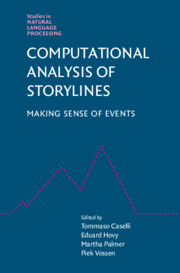Book contents
- Frontmatter
- Contents
- List of Contributors
- Introduction and Overview
- Part One Foundational Components of Storylines
- Part Two Connecting the Dots: Resources, Tools, and Representations
- 7 The Richer Event Description Corpus for Event–Event Relations
- 8 Low-Resource Event Extraction via Share-and-Transfer and Remaining Challenges
- 9 Reading Certainty across Sources
- 10 Narrative Homogeneity and Heterogeneity in Document Categories
- 11 Exploring Machine Learning Techniques for Linking Event Templates
- 12 Semantic Storytelling: From Experiments and Prototypes to a Technical Solution
- Author Index
9 - Reading Certainty across Sources
from Part Two - Connecting the Dots: Resources, Tools, and Representations
Published online by Cambridge University Press: 06 November 2021
- Frontmatter
- Contents
- List of Contributors
- Introduction and Overview
- Part One Foundational Components of Storylines
- Part Two Connecting the Dots: Resources, Tools, and Representations
- 7 The Richer Event Description Corpus for Event–Event Relations
- 8 Low-Resource Event Extraction via Share-and-Transfer and Remaining Challenges
- 9 Reading Certainty across Sources
- 10 Narrative Homogeneity and Heterogeneity in Document Categories
- 11 Exploring Machine Learning Techniques for Linking Event Templates
- 12 Semantic Storytelling: From Experiments and Prototypes to a Technical Solution
- Author Index
Summary
Witness testimony provides the first draft of history and requires a kind of reading that connects descriptions of events from many perspectives and sources. This chapter examines one critical step in that connective process, namely, how to assess a speaker's certainty about the events they describe. By surveying a group of approximately 300 readers and their approximately 28,000 decisions about speaker certainty, this chapter explores how readers may think about factual and counterfactual statements, and how they interpret the certainty with which a witness makes their statements. Ultimately, this chapter argues that readers of collections of witness testimony were more likely to agree about event descriptions when those providing the description were certain, and that readers' abilities to accept gradations of certainty were better when a witness described factual, rather than counterfactual or negated events. These findings lead to a suggestion for how researchers in natural language processing could better model the question of speaker certainty, at least when dealing with the kind of narrative nonfiction one finds in witness testimony.
- Type
- Chapter
- Information
- Computational Analysis of StorylinesMaking Sense of Events, pp. 187 - 202Publisher: Cambridge University PressPrint publication year: 2021



